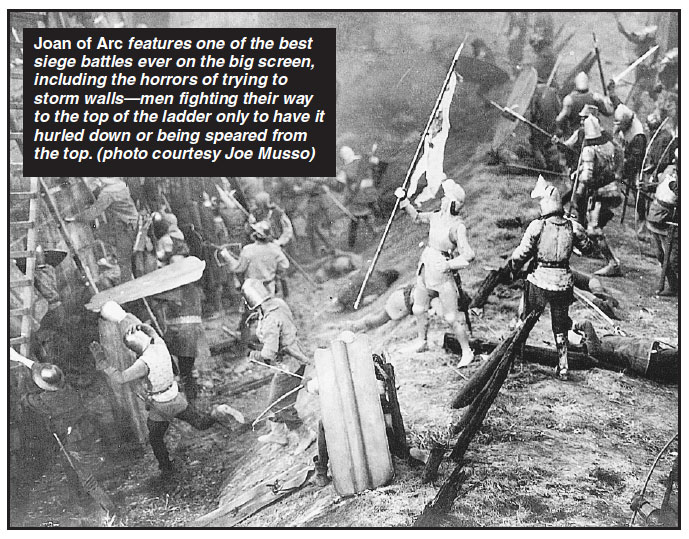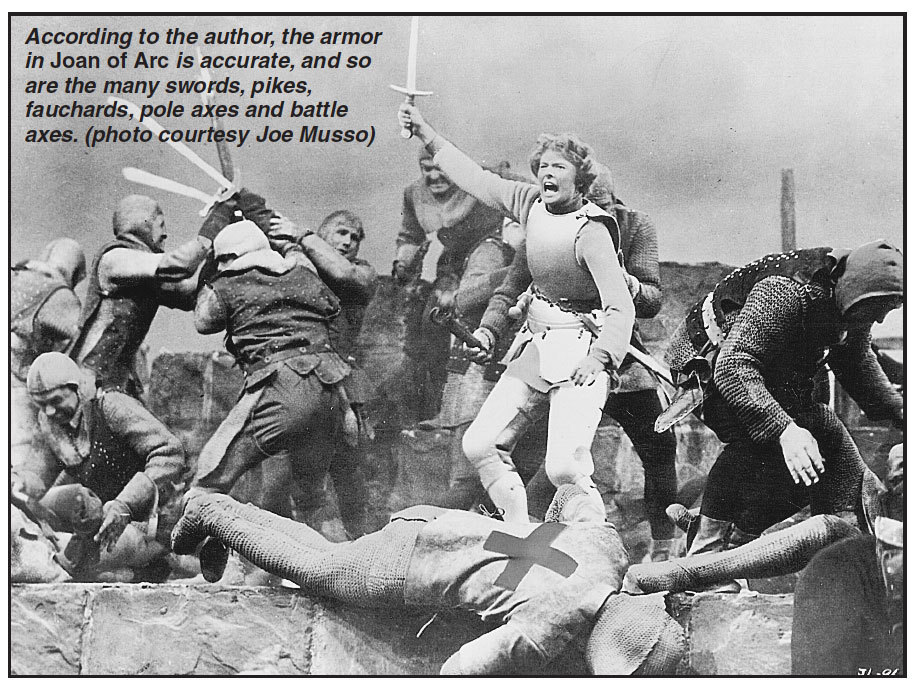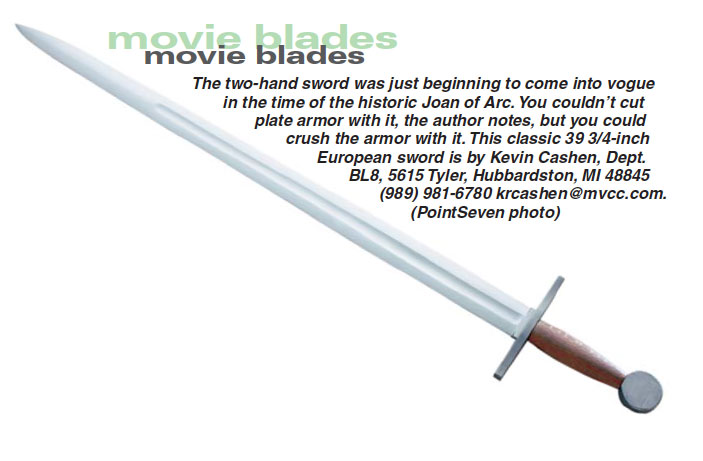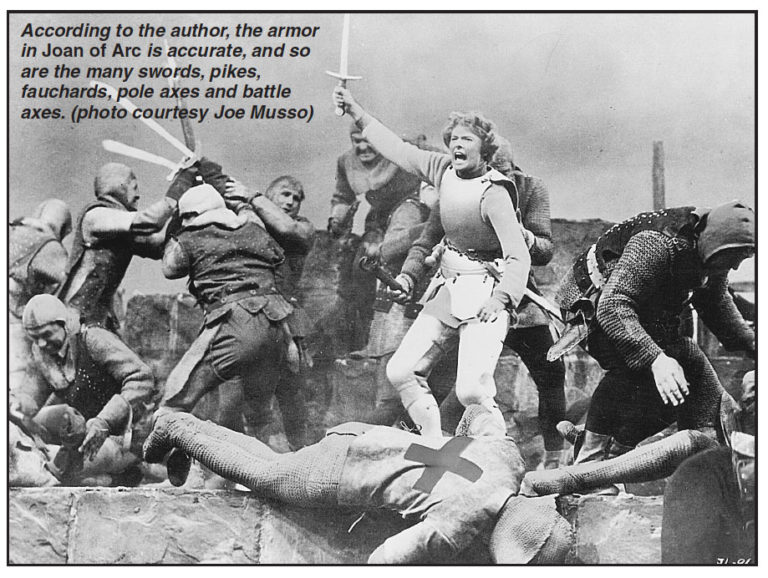
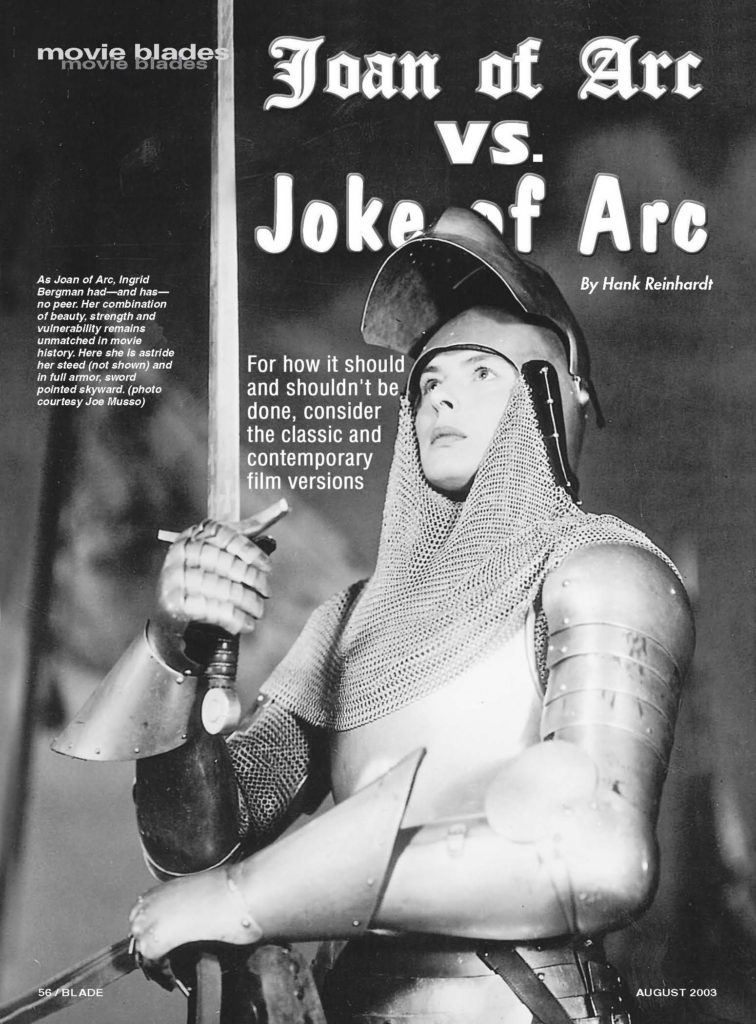
Editor’s note: This article originally appeared in the August 2003 issue of BLADE magazine. You can read more from BLADE‘s archives with this extensive collection.
When I first heard of The Messenger, the 1999 movie version of the Joan of Arc story, I thought it best to ignore it. It just didn’t sound very good. However, I caught a trailer on HBO about the film—directed by Luc Besson and starring Milla Jovovich as Joan and John Malkovich as The Dauphin—and was quite impressed.
According to the trailer, the producers spent an enormous amount of time researching the era in which the story is set, including the armor and weapons. They also researched Joan and reportedly would present a different portrait of “the Maid of Orleans.”
On this basis, my wife, Toni, and I journeyed to the theater prepared to see the new portrait, and to appreciate the research into the clothing and the arms and armor.
What Went Wrong
 One of the most notable things about the movie was the popcorn. It was really fresh and delicious. The drinks were well mixed, and, as usual, the price was sky high—but the popcorn was worth it.
One of the most notable things about the movie was the popcorn. It was really fresh and delicious. The drinks were well mixed, and, as usual, the price was sky high—but the popcorn was worth it.
I regret to say, however, that I have a weak stomach. Oh, scenes of carnage don’t bother me, but really bad acting, directing and outright falsehoods in a movie have a tendency to make me want to heave!
Nonetheless, I’m not a coward. I walked to the restroom, threw some cold water on my face, steeled my nerves, and went back to try to watch the rest of the movie.
I failed.
I made it through the fall of the Tyrell and the relief of Orleans. About 10 minutes later, though, my stomach quailed at what I watched on the screen, and Toni and I had to leave. Meanwhile, a couple of my friends braved the whole film. They told me that as the time approached for Joan to be burned at the stake, many in the audience were shouting, “Burn her! Burn her!”
Not Falling for Those Cheap Movie Swords
If the producers paid for research on The Messenger, they should get their money back.
All the armor looks as if it’s straight out of some cheap fantasy movie, and the same goes for the swords and other weapons. However, the war hats look pretty good. As for the fighting, it’s more ludicrous than anything else.
After the fall of the Tyrell, the camera pans somewhat lovingly over the scene of “carnage.” There’s one severed foot, a “tastefully arranged” group of what might be entrails and, I think, an arm lying about. In short, it’s the most unrealistic battle scene since the Saturday serials.
Actually, I would be willing to overlook a lot of the flaws and errors if the movie had anything else going for it, but this one doesn’t.
The Hundred Years War helped create a time of deep cynicism that co-existed with a profound and strongly held religious belief. Whatever one’s opinion of Joan of Arc—and whatever the reality actually was—she was able to lead and inspire many men, those sincere in their religious belief, as well as those quite cynical.
On the other hand, this movie’s version of Joan could, and did, inspire an exodus from the theater. Don’t waste your time with this one. For one thing, I doubt that you’ll be as lucky with the popcorn as we were.
Better Swords, Better Movie: Joan of Arc (1948)
After we left the theater from watching The Messenger, I promised Toni that I would show her the definitive film version of Joan of Arc. Produced by Walter Wanger in 1948, Joan of Arc remains one of the most stupendous epics ever produced for the silver screen.
As Joan, Ingrid Bergman had a positively ethereal beauty that really hits home in the movie. She was also a tremendous actress and comes across as a confused peasant girl, driven by forces she only partially understands but in which she fully believes.
La Hire, one of Joan’s great battle captains, is well played by a bluff, tough Ward Bond. Since I always liked what I read about La Hire, I was pleased to see him played so admirably.
The Dauphin, a somewhat feckless and timid person, is well handled by Jose Ferrar. I could go on and on, as everyone in the movie does a superb job and each is quite believable in his/her role.
The primary battle in the movie is the capture of the Tyrell and the relief of Orleans that’s besieged by an English army under the command of Sir William Gladsdale. This is one of Joan’s first battles and in it she’s wounded by a crossbow bolt.
She regains consciousness and insists on leading a final charge against the Tyrell, which falls in the ensuing battle.
This is one of the best siege battles ever on the big screen, and is worth the price of the movie rental alone. You see arrows flying from crossbows and bows, and the horrors of trying to storm walls—men fighting their way to the top of the ladder only to have it hurled down or being speared from the top.
As the Tyrell falls, La Hire climbs over the wall and shouts for Gladsdale, and the two meet in the center and fight with two-hand swords. La Hire drives him back and, rather than surrendering, the Englishman falls into some burning debris.
Getting the Two-Hand Swords Right

The two-hand sword was just beginning to become popular at that point in history, and for two knights in full plate armor it was a handy weapon to have. Certainly, you can’t cut plate armor with a regular sword but you can crush it.
The movie is well acted and well done, but even more impressive is the costuming, right down to the haircuts of the men. The hair is worn thick and cut into the shape of a bowl. This was done at first to provide extra padding under the helmet but also became the fashion for the dandies, even if they never fought. The armor is accurate and so are the many swords, pikes, fauchards, pole axes and battle axes.
See this one. It’s fun and a good movie as well.
 NEXT STEP: Download Your Free KNIFE GUIDE Issue of BLADE Magazine
NEXT STEP: Download Your Free KNIFE GUIDE Issue of BLADE Magazine
BLADE’s annual Knife Guide Issue features the newest knives and sharpeners, plus knife and axe reviews, knife sheaths, kit knives and a Knife Industry Directory.Get your FREE digital PDF instant download of the annual Knife Guide. No, really! We will email it to you right now when you subscribe to the BLADE email newsletter.


